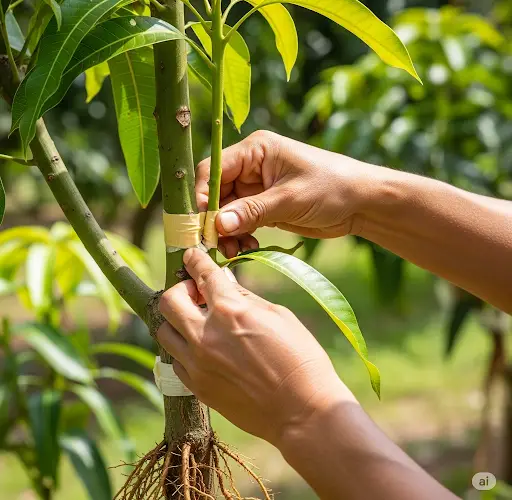Grafting is a time-tested horticultural technique that allows gardeners to clone desirable fruit varieties, speed up fruit production, and create stronger, more resilient trees. Mango trees, in particular, respond well to grafting, and with a little patience and the right technique, it’s entirely possible to successfully graft mango trees at home—even if you’re working in a small garden or using potted plants.
This article introduces a unique home grafting method for mango trees that’s simple, cost-effective, and ideal for beginners or hobbyist gardeners. With this approach, you can replicate your favorite mango variety, promote faster fruiting, and enjoy a more productive tree in your own backyard.
Why Graft Mango Trees?
Growing mangoes from seeds doesn’t always guarantee the same quality of fruit. In fact, many seed-grown mangoes revert to wild or inferior varieties. Grafting helps solve this problem by:
-
Cloning superior varieties – Ensuring your tree produces the exact same fruit as the parent.
-
Speeding up fruit production – Grafted trees often bear fruit in as little as 2–4 years.
-
Improving disease resistance – Combining a hardy rootstock with a high-quality scion can create a stronger, more resilient tree.
What You’ll Need
To begin grafting mango trees at home, gather the following materials:
-
A healthy mango seedling or sapling (used as rootstock), ideally 6 months to 1 year old
-
A scion – a healthy, pencil-thick branch from a mature tree that produces your preferred variety of mango
-
A sharp grafting knife or blade
-
Grafting tape or plastic wrap
-
Rubber bands or soft string
-
Clean cloth and rubbing alcohol (for sterilizing tools)
Optional: A clear plastic bag or small plastic bottle for creating a mini-greenhouse effect after grafting.
Step-by-Step Guide to the Unique Home Grafting Method
This method uses a variation of the cleft graft, which is simple and highly effective for mangoes.
Step 1: Prepare the Rootstock
Select a vigorous, disease-free mango seedling with a stem about the thickness of a pencil. Trim the top off the rootstock at about 12–18 inches above the soil, making a clean, horizontal cut.
Use a sharp, sterilized blade to split the stem vertically down the center to a depth of about 1.5 to 2 inches. This will create a cleft to insert the scion.
Step 2: Select and Prepare the Scion
The scion should be a straight, healthy stem taken from a mature mango tree known to produce good fruit. Choose one with 3–4 buds, and remove all leaves to reduce moisture loss.
Trim the bottom end of the scion into a wedge shape, about 1.5 inches long, so it will fit snugly into the rootstock cleft. This angled cut is crucial for good cambium contact.
Step 3: Insert the Scion into the Rootstock
Gently open the cleft in the rootstock and insert the scion so that the cambium layers (the green layer just beneath the bark) of both pieces touch on at least one side. Proper cambium contact is the key to successful grafting.
Step 4: Secure the Graft
Wrap the graft union tightly with grafting tape, plastic wrap, or a strip of soft plastic. You can secure it further with a rubber band or string. Make sure the joint is firmly held in place and sealed to prevent moisture loss and infection.
For better humidity retention, you can cover the graft with a clear plastic bag or cut plastic bottle to act as a mini-greenhouse. This helps the scion stay hydrated while it’s forming a bond with the rootstock.
Step 5: Care After Grafting
Place the grafted plant in a warm, shaded location with indirect light. Avoid direct sun for the first few weeks.
-
Check the graft weekly to ensure no mold or rot is developing.
-
After 2–3 weeks, you may see signs of budding on the scion.
-
Once the graft union looks healed and new shoots appear, gradually expose the plant to more sunlight.
-
Remove the plastic wrap and support structures slowly to avoid shocking the plant.
Success Tips for Home Mango Grafting
-
Timing matters – The best time to graft mango trees is during the dry season or early in the rainy season when the sap is flowing.
-
Hygiene is essential – Always sterilize your tools before making cuts.
-
Use healthy material – Both rootstock and scion should be disease-free and well-hydrated.
-
Be patient – Not all grafts take on the first try. Don’t be discouraged—try again with fresh material if needed.
Conclusion
With this unique yet straightforward grafting method, home gardeners can successfully propagate their favorite mango varieties without needing expensive tools or commercial nursery conditions. This technique not only enhances fruit production but also allows you to grow multiple varieties in a small space, even in containers.
Whether you’re a beginner or a plant enthusiast, grafting mango trees at home is a rewarding practice that deepens your connection to nature and leads to delicious results in just a few seasons.



